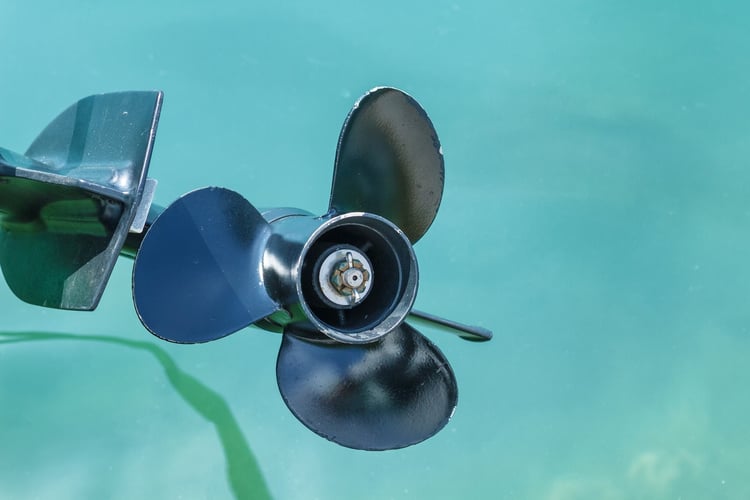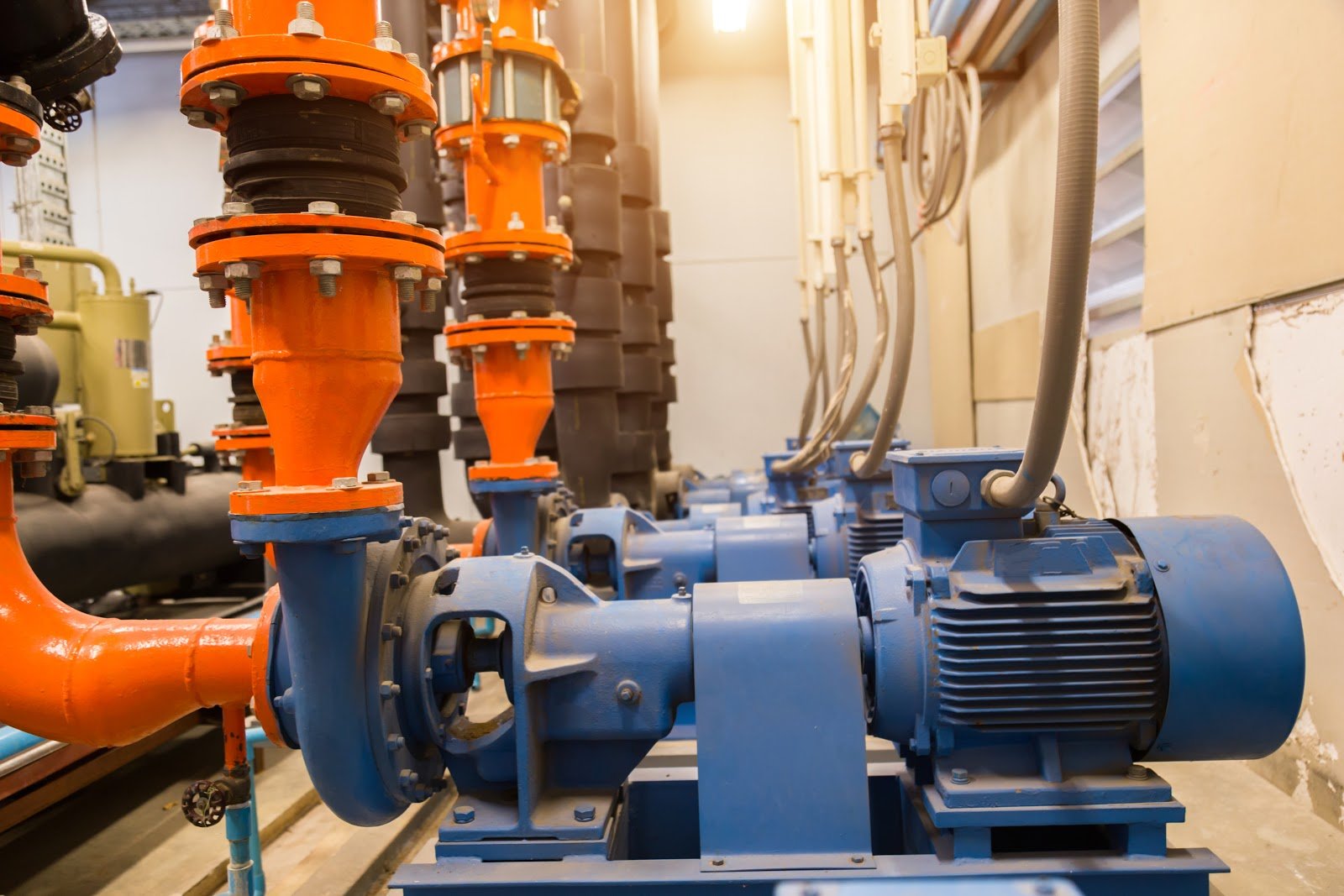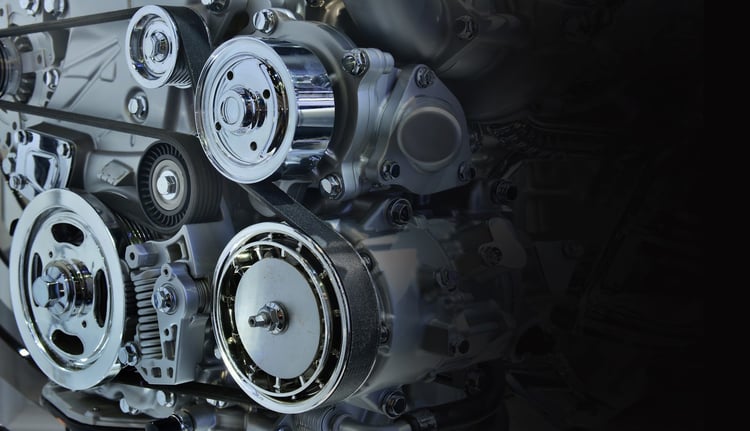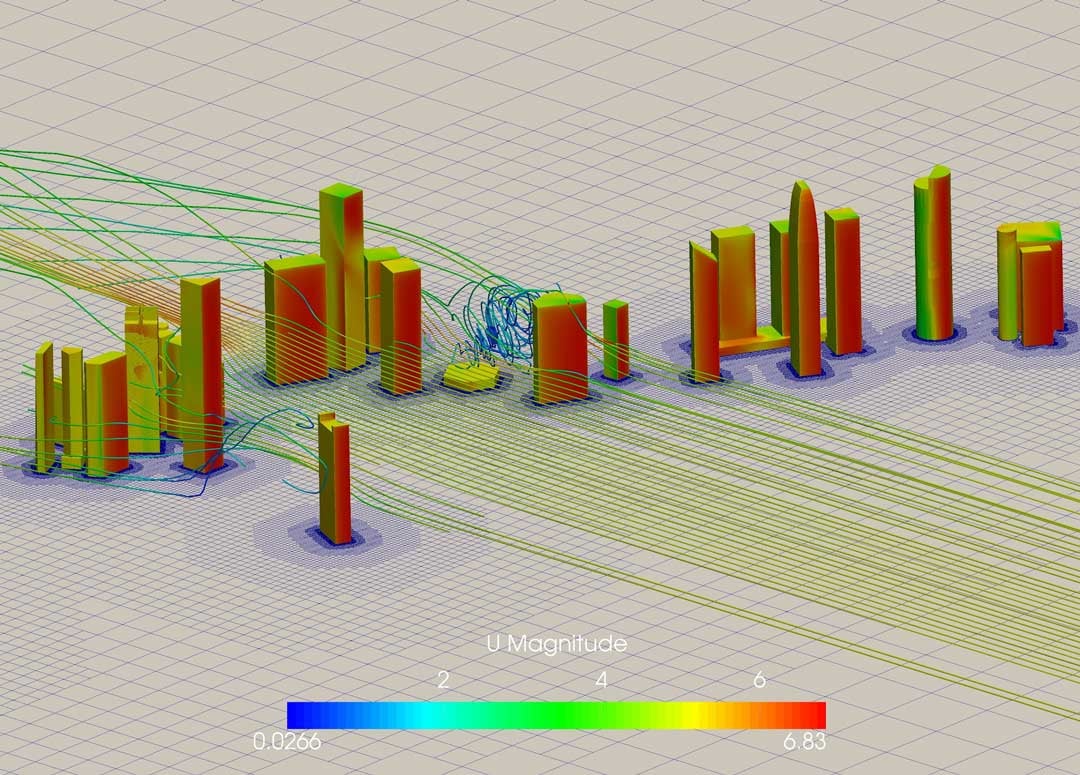Computational fluid dynamics (CFD) is a science that uses data structures to solve issues of fluid flow -- like velocity, density, and chemical compositions.
This technology is used in areas like cavitation prevention, aerospace engineering, HVAC engineering, electronics manufacturing, and way more.
Below is a list of the most common CFD simulation applications in use today.
1. CFD Simulation for Preventing Cavitation

Cavitation is the formation of vapor bubbles within a liquid, and occurs when an object (such as a propellor) moves through the liquid. Cavitation can cause damage to propellers, nozzles, turbines, spillways, and valves.
Cavitation is a critical fluid dynamics problem that impacts a wide swath of engineering domains.
The biggest issue?
It’s very difficult to detect cavitation-caused damage to a component during physical stress testing — because the damage is gradual, and shows no obvious effects until it reaches a critical threshold.
For example, one way to measure cavitation damage to a propeller is by using instruments to measure vibrations and noise. But most instruments are not sensitive enough to accurately measure this type of damage.
Cavitation simulation through CFD, however, can help engineers set tiny thresholds that would be difficult to measure in the physical world. They can measure at a very granular level to compare alternative products and designs to improve flexibility, durability, and safety of their projects.
2. Simulating Rotating Machinery using CFD

Rotating machinery such as compressors, steam pumps, gas turbines, and turbo-expanders have one thing in common: the cyclic load acting on the structure.
Labyrinth seals are used in various rotating types of machinery to reduce leakage flow. The gas passing through the seals often creates a driving force that leads to unstable rotor vibration.
What is essential here is to be able to determine the dynamic rotor force that creates instability.
Once again, rather than investing in constant prototyping and physical stress testing, CFD simulation can be used to test a variety of design variables to find the most ideal construction of rotating machinery.
3. CFD Simulation for Laminar and Turbulent Flow

Turbulence is the sudden violent movement of air, water, or other liquids. It is one of the most disastrous and unpredictable weather phenomena faced by pilots. In fact, extreme turbulence can make it impossible for airline pilots to control their planes, and may even cause serious injuries to passengers.
CFD simulations use turbulence models to predict the effect of turbulence on a CAD engineered design.
One of the most common models for simulating turbulence is Generalized k-omega (GEKO) in ANSYS. GEKO helps tailor turbulence models to a wide variety of applications by allowing users to adjust individual parameters of the simulation while maintaining the model calibration
4. Heating, Air conditioning, and Ventilation (HVAC) Applications of CFD Simulation

Despite being an overlooked fixture of our everyday lives, HVAC systems that pump and condition air into our homes and offices require intensive engineering and planning.
In order to condition the air of a space effectively, keep air flowing through a room, and ensure high indoor air quality (IAQ), HVAC products have to take advantage of the physics of fluid dynamics.
Creating HVAC diffusers, air handling units, and FTUs typically requires rigorous testing to ensure they can circulate and condition air effectively, and meet IAQ standards.
As such, many HVAC equipment manufacturers have turned to CFD simulation to speed up prototyping and validating new designs. CFD simulation allows engineers to analyze the potential performance of their products in different spaces, and in different configurations.
5. Battery Simulation with CFD

At face value, the battery design process seems to have little in common with the likes of aerospace and HVAC design — where airflow plays a vital (and obvious) role in the core function of a product.
But battery design is a multidisciplinary process that requires several engineering practices — including chemical, electrical, thermal, and fluidic engineering. And as such, CFD simulation can play an important role in optimizing the performance and safety of batteries (while using less time and resources on physical testing).
CFD software like Simulia can help battery manufacturers visualize with 3D and solve problems associated with rapid discharging, excessive ambient heating, and overcharging — which not only impact battery life, but also consumer safety.
6. Simulating Aerodynamics With CFD

Aerodynamics is the study of how air flows around objects (like aircrafts or automobiles).
It is perhaps the most well known application of CFD — as automobile designers, aerospace engineers and sports equipment manufacturers all make use simulation software to reduce the drag and friction of air while improving the efficiency of their products.
Beyond being able to design aerodynamic products without investing in many physical prototypes, simulation makes it possible for engineers to test very small changes to their design to maximize performance — dozens or hundreds of times before they go to production.
7. Heat Transfer and Thermal Management Simulation in CFD

Heat transfer and thermal management is the discipline of measuring how heat moves through solid-fluid designs (e.g. pipes that transfer hot liquid) — and how to optimize designs using the principles of heat conduction, convection, or radiation.
Thermal management is vital for ensuring the structural integrity and safety of any designs that require moderate heat or cold. It can also be used to optimize the performance and efficiency of designs that use heat or combustion for power.
Most professional CAD software packages (like SolidWorks) have native support for simulating heat transfer models.
CFD simulation is used to optimize heat transfer in everything from automobile engine designs to coffee machine designs. It is also vital to a myriad of other simulation types mentioned on this list (like HVAC) — where heat transfer is an integral component of a product’s core function.
8. Pipe and Valve Simulation with CFD

Fluid flow can exert immense pressure on pipes and valves — and can lead to critical deformation and failure if it isn’t properly accounted for.
As such, oil refineries, natural gas pipelines, and residential plumbing must all be optimized for fluid flow to achieve safety and prevent long-term damage to expensive equipment.
Prior to the rise of CFD simulation, this sort of optimization required trial and error. Systems of piping were built with best-guess estimates, and were refined or revised after failure.
With CFD simulation, engineers can model the performance of an entire system of pipes or isolate a single component (like a valve) to decrease the likelihood of failure. CFD simulation could also be used to investigate failure of aging infrastructure after-the-fact, giving engineers a more accurate picture of what happened.
9. Simulating Electronics Cooling with CFD

All electronics in use today require some form heat management (whether it’s heatsinks, vents, fans, thermal components, or a combination). This is because chips like GPUs and CPUs begin to malfunction as they overheat. These components need to be kept relatively cool to maintain performance (usually under 85°C).
Without extensive simulation or testing, electronics manufacturers would frequently release products to market (like phones, toys, computer chips, etc.) that failed due to overheating.
CFD simulation can be used to test and organize the most ideal placement of components (heatsink, fan, etc.) to ensure sensitive chips don’t overheat.
10. Turbomachinery CFD Simulation

Turbomachinery is a mechanical engineering concept that describes machines that impart energy from a rotor to a fluid (like a compressor or a turbine).
Aircraft jet engines are a common example of turbomachinery, as they are gas turbines that produce thrust from exhaust gases.
CFD software is used extensively in the design and optimization of turbomachinery, from pre-processing, modelling, meshing, all through to post-processing.
11. High Rheology Material CFD Simulation
High rheology materials are solids that can behave as liquids when forces and stresses are applied to them. Examples of such materials include:
- Plastics
- Polymers
- Glass
- Metals
- Cement
By using techniques like blow molding, thermoforming, and extrusion — manufacturers can shape these solids into a final product.
Through the application of CFD simulation, manufacturers can accelerate their rheology material design processes while minimising energy and raw material demands. They can identify cost savings by changing the shape of manufacturing dies, reducing excess material, and quickly prototyping rheological designs.
12. Simulating Reacting Flows and Combustion with CFD

Flowing fluids that are chemically reactive (in the case of a combustion engine, for example), are referred to as “reacting flows” in simulation.
These types of flows represent a difficult physics problem for engineers.
Predicting the behaviour of reacting fluid at a chemistry bench scale (millimeters) is one thing — but doing so at a solution level (at cubic liters) while taking turbulence into account is immensely difficult.
And yet, it’s an important problem.
Being able to understand the underlying chemistry and physics of reacting flows is pivotal in increasing energy efficiency, fuel flexibility, and reduced emissions in the automotive, aerospace, and energy sectors.
This is an area where CFD simulation excels. It can handle complex, multi-physics problems like reacting flows — giving manufacturers insights about their products that would be nearly impossible to calculate manually — without requiring expensive physical testing.
13. Incompressible and Compressible Flow with CFD Simulation

(Source: SimScale)
Compressible flow refers to a fluid flow where density is not constant.
In other words, a fluid like oxygen, whose density can be compressed or decompressed with pressure changes — has a compressible flow.
Incompressible flow refers to a fluid whose density changes are negligible, regardless of pressure.
Water flowing through a pipe has an incompressible flow, because pressure will have an infinitesimal impact on its density.
Both types of flow present unique challenges for manufacturers and engineers. Engineers working on aerodynamics, for example, have to take the compressibility of oxygen (with objects traveling at different speeds) into account in their analysis. Conversely, industries that work with incompressible fluids must take the violent, powerful, and chaotic turbulent flows into account with their calculations.
And in the case of aerospace — where both types of calculations may need to be combined in a single analysis — testing and planning can become incredibly complex.
This is why CFD simulation is an absolute necessity for many modern manufacturers. Software like SimScale allows engineers to analyze incompressible and compressible flows in one simulation by assigning unique properties to different fluids.
Closing Thoughts
Before the advent of simulation, many of the world’s practical physics problems were solved with expensive (and time-consuming) physical testing. Companies whose products forewent rigorous testing paid considerably more with product failures and recalls (and reputation damage) in the long term.
But with the advent of simulation modeling, engineers and designers across all industries have gained access to an inexpensive way to test their products in virtually any conditions.
Computational fluid dynamics in particular allows engineers to test and improve designs of products where fluid flow, turbulence, and heat transfer are vital calculations.
But testing is only a part of the equation.
Being able to update CAD designs quickly and efficiently to fix problems that were flagged by CFD analysis is still a problem for designers — as it often requires a lot of manual reworking.
To enable large scale adoption of simulation across industries, simulation applications need to become easier-to-use.
If you’re a designer or an engineer working with CAD and simulation, you’re intimately familiar with the amount of work required to redesign products based on simulation outputs. Most CFD software will not update your CAD model. Instead, they give you a “vector field” to show the required deformation to optimize your model. It is then the designer’s responsibility to manually alter the design.
This manual re-design process can be automated by using Spatial’s BRep morphing toolset. Given a vector deformation field (a set of before and after points), this toolset lets you morph any BRep geometry automatically. Thus, engineers can accommodate simulation results back into their design, easily.
.png?width=591&name=FVA%20Case%20Study%20(1).png)




















